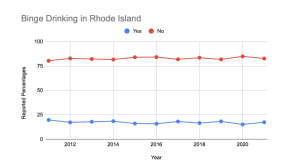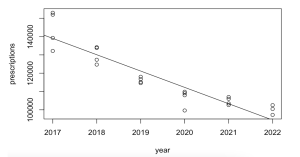
By Infectious Disease Society (Anusha Srinivasan, Meghan Gormley, Ivy Koh, Pierre Jolin)
Illustration by Zhao Yan
Abstract
COVID-19 was first reported in the United States in January 2020. By March 2020, most state governments instituted stay-at-home orders. These laws required non-essential businesses to close and prohibited large gatherings as well as the continuation of in-person schooling. R and Google Sheets were used to analyze trends in substance use in Rhode Island before, during, and after these quarantine measures were implemented. Specifically, we examine changes in alcohol and opioid use at a county level and how these trends are correlated with race and income. The results indicate an increase in opioid fatality rate, but no statistically significant differences in metrics of alcohol use. Increases in opioid use were most significant among the African American population. Future research will evaluate these changes in substance use with respect to other demographic factors including ethnicity and education to determine the groups that are most vulnerable and stand to benefit most from public health intervention.
Introduction
The first case of COVID-19 in the United States was first reported in January 2020 and marked the beginning of a global crisis that swiftly led to unprecedented disruptions in daily life. Most state governments in the United States instituted stringent measures, including stay-at-home orders, by March 2020. These laws required non-essential businesses to close and prohibited large gatherings. Students were sent home from school and social distancing measures were enforced in public spaces.1 These measures were crucial for protecting public health but started a new era of social and personal challenges for all individuals.
COVID-19 quarantine and social distancing measures imposed unique psychological challenges nationwide. Within a short time period, individuals faced unforeseen lifestyle changes and new stressors. Many people experienced challenges such as overseeing their children’s remote schooling, concerns for the health of their families and friends, and the anxiety associated with food insecurity. The economic implications of the pandemic further exacerbated stress, contributing to widespread unemployment and financial strain for many Americans. Compounding these challenges was the reduction in access to traditional coping strategies, including social interaction and physical activity. A notable consequence was the negative impact on mental health as reported by many adults in the US. This, in turn, led to unfavorable changes in the use of alcohol and drugs, gambling, and other risky behaviors.2
With the social and personal stressors caused by the pandemic, changes in substance use can be expected. Such patterns of behavior during times of national stress have been observed before, as seen in the aftermath of the September 11th terrorist attacks in New York City, where the use of cigarettes, alcohol, and marijuana increased in the months following the tragedy.1 Beyond the psychological and economic aspects, the pandemic also disrupted access to essential healthcare services, particularly for those with substance use disorders. In-person treatment for conditions like opioid use disorders faced significant limitations at the onset of the pandemic, creating additional hurdles for individuals already grappling with the challenges of addiction.2
This paper aims to comprehensively review trends in substance use in Rhode Island before, during, and after the implementation of quarantine measures. Specifically, we will examine changes in alcohol and opioid use at a county level. We will also explore how trends in substance use by county are correlated with demographic factors like race, income, and education level.
Methods
Alcohol
In this study, we leveraged datasets obtained from the Behavioral Risk Factor Surveillance System (BRFSS) administered by the Centers for Disease Control and Prevention (CDC). The BRFSS is a comprehensive survey conducted annually in the US and serves as a valuable source of information for public health research and policy development. The survey is a state-specific telephone survey. We analyzed the reported alcohol consumption and binge drinking rates in Rhode Island from the BRFSS datasets. According to the survey, alcohol consumption is defined as at least one standard drink of alcohol within the past 30 days; binge drinking is defined as more than 5 standard drinks for males and more than 4 standard drinks for females in one occasion. We graphed the alcohol consumption and binge drinking data in two separate graphs using Google Sheets.
Opioids
Opioid prescription data was compiled from the Rhode Island Department of Health into R Studio to analyze prescription rates in Rhode Island. Overdose data, also from the Rhode Island Department of Health, was imported into Google Sheets and trends were analyzed between race and resident municipality.
Results
Alcohol

Figure 4. Binge Drinkers (>5 drinks for males, >4 drinks for females in one occasion) in RI

Figure 5. Alcohol Consumers (Adults who have had at least one drink of alcohol within the past 30 days) in RI
The analysis of alcohol consumption and binge drinking patterns in Rhode Island adults throughout the pandemic did not reveal any statistically significant differences. Alcohol consumption was steadily tracked at approximately 60% from 2011-2021. Conversely, adults that did not partake in alcohol consumption during this time period were approximately 40% of the population. Binge drinking was also steadily tracked at approximately 20% for both males and females from 2011 to 2021. Adults who denied binge drinking were constantly at 80% throughout the period. The data for both binge drinking and alcohol consumption suggest that there was no significant change in alcohol drinking trends from pre-pandemic to pandemic years.
Opioid use

Figure 1. Number of Opioid Prescriptions per Quarter in Rhode Island From 2017-2022

Figure 2. Rhode Island Opioid Overdose Rates by Race From 2016-2021
Prescription data (Figure 1) suggest that from pre-pandemic years through the early years of the pandemic the number of opioid prescriptions decreased in Rhode Island. Thus prescription-based use for opioids decreased in the state since 2017. Furthermore, the downward trend did not appear to be significantly impacted by the pandemic years. Rather it appeared to be a continuation of the downward trends. This data, however, is limited because it only includes numbers of prescriptions for opioids and not numbers from other opioid sources, such as illicit markets. Overdose data (Figure 2) suggests that there was an upward trend in overdoses especially from 2020 to 2021 (during the COVID-19 pandemic). Furthermore, this data suggests that African Americans in Rhode Island are disproportionately impacted by adverse outcomes from opioid overdose. This data is revealing of the trends in negative outcomes of opioid use; however, it is limited in shedding light on the cause of these trends and disparities.
Discussion
Alcohol
The results suggested that alcohol consumption and binge drinking rates were not significantly different when comparing pre-pandemic, pandemic, and post-pandemic rates. This suggests that there were no significant increases or decreases in alcohol-related behavior in adults in Rhode Island. Thus, public health and community-based resources may not be as impactful if directed toward alcohol use in comparison to the challenges posed by opioid use. However, it is important to note some key limitations to these findings. Most importantly, the BRFSS survey was self-reported, which relied on individuals to report their own alcohol consumption accurately. This can be influenced by a variety of factors such as social desirability bias or memory limitations in recalling drinking habits. Regardless of these potential inaccuracies in data collection, reducing overall alcohol consumption and binge drinking is still important for the health of the Rhode Island population. Future research should be focused on understanding the demographic differences in alcohol use to determine if certain populations would benefit from targeted public health interventions.
Opioids
Rhode Island overdose fatality has increased throughout the pandemic compared to prior years. Stratification by race/ethnicity reveals that overdose has increased most among the African American population. In addition, when overdose data was stratified amongst municipalities, most locations have seen an increase in overdose fatality during the pandemic as compared to the years prior. When examining the source of these opioids, prescription opioid data reveals that prescriptions have decreased over the course of the pandemic, which seems to follow the previous years’ trends.
Considering the overall overdose fatality trend along with the decrease in prescription opioids, the data suggests that lethality is increasing due to factors external to the misuse of prescription opioids. One possible explanation for this trend is the wider availability of non-prescription opioids, which could be considered a continuation of the rise in deaths due to synthetic opioids, such as fentanyl, observed throughout the U.S. since the mid-2010s.3 This trend is aligned with CDC data which showed a 41.5% increase in overdose deaths due to synthetic opioids in Rhode Island from 2019 to 2020.4
The demographic trends suggest that the Rhode Island African American population is most likely to experience adverse outcomes related to opioid use. This may be explained by factors such as structural racism and decreased access to health resources that may prevent overdose death.
Stratification by municipality demonstrated that Woonsocket, Rhode Island had the highest opioid overdose fatality rate, and U.S. Census Data reveals that the poverty rate of this municipality is 18.7%. A high overdose fatality rate was also observed in Providence which has a poverty rate of 21.5%.5 The results suggest that more under-resourced populations are at higher risk for adverse outcomes related to opioid use during the pandemic. These effects were exacerbated in lower-income populations.
The findings also suggest that less resourced populations face a higher risk of fatality. The decrease in prescription opioids suggests that the misuse of prescriptions is decreasing; however, coupled with the finding that lethality is increasing due to opioids, it suggests that the source of opioid overdose has shifted to illicit drug sources such as synthetic opioids (e.g. fentanyl) or semi-synthetic opioids (e.g. heroin). Possible policy solutions to be implemented to address this crisis may include widespread distribution of fentanyl test strips, expanding drug checking programs, supervised consumption sites, or increasing access to overdose prevention medication such as Naloxone.6
Conclusion
This study suggests that harm reduction measures are likely needed to reduce the fatality of drug use among the Rhode Island population. Resources should especially be directed towards at-risk populations, such as individuals living in poverty and African American communities. The mentioned strategies may help to mitigate some of the adverse outcomes specifically associated with opioid use. Further research and robust policy solutions are needed to evaluate other trends in substance use, including alcohol.
References
- Avena NM, Simkus J, Lewandowski A, Gold MS, Potenza MN. Substance Use Disorders and Behavioral Addictions During the COVID-19 Pandemic and COVID-19-Related Restrictions. Front Psychiatry. 2021;12:653674. Published 2021 Apr 16. doi:10.3389/fpsyt.2021.653674
- Rogers, Andrew. Psychological Factors Associated with Substance Use Initiation during the COVID-19 Pandemic. Psychiatry Research, Elsevier, Published 2020 Aug 18. doi:10.1016/j.psychres.2020.113407
- Rudd RA, Seth P, David F, Scholl L. Increases in Drug and Opioid-Involved Overdose Deaths — United States, 2010–2015. Morbidity and Mortality Weekly Report. 2016;65(50 & 51):1445-1452. https://www.jstor.org/stable/24876516
- CDC. Drug overdose deaths. www.cdc.gov. Published June 23, 2021. https://www.cdc.gov/drugoverdose/deaths/index.html
- United States Census Bureau. U.S. Census Bureau QuickFacts: Woonsocket City, Rhode Island. www.census.gov. Published 2022. Accessed October 29, 2023. https://www.census.gov/quickfacts/fact/map/woonsocketcityrhodeisland
- Centers for Disease Control and Prevention. Evidence-Based Strategies for Preventing Opioid Overdose: What’s Working in the United States | Drug Overdose | CDC Injury Center. www.cdc.gov. Published June 23, 2021. https://www.cdc.gov/drugoverdose/featured-topics/evidence-based-strategies.html